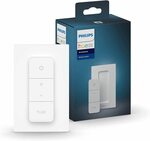Seems to be the cheapest for the newer switch on Amazon AU according to 3camels. But not the cheapest ever, if you managed to grab an older version of the switch (I'm not too sure what the difference is between the old and the new). Tamagotchi Breeder lists the differences in a comment
Hope it helps someone!
(I copied the 'Delivery ($0 with Prime/ $39 Spend)' from another post - I've no idea if this is still true, and I'm struggling to find the current non prime shipping rates)
Thanks to nbn's comment:
Same price at JB HiFi so potentially you can get extra 10% off if you snapped the ultimate gift cards from WW previously.



 CamelCamelCamel
CamelCamelCamel
Are these for controlling hue bulbs only? If you are installing a smart switch why not just use one that can control regular bulbs as long as you are happy with the wiring of the lights and switches?
I have always wondered the benefit of smart bulbs vs smart switches and am pretty sure I would go the switch route if I owned a place. I have a couple LIFX bulbs in lamps but it would be super pricy to switch the whole place to them.
Anyone have any experience with the two options?